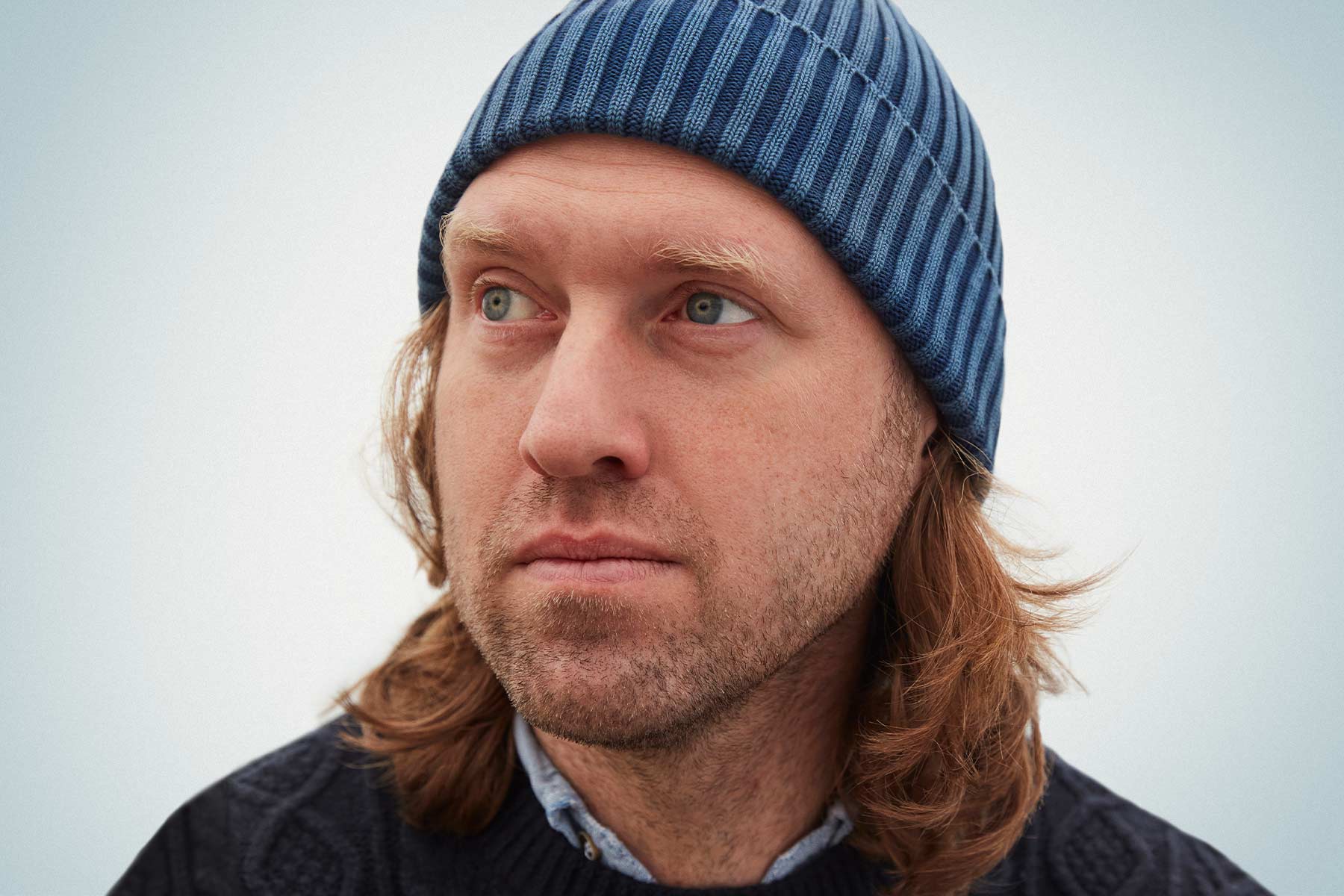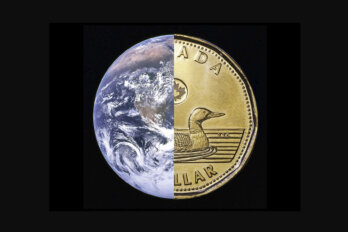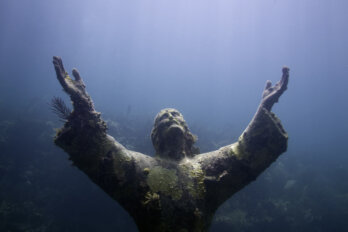Soren Brothers couldn’t shake off a recurring nightmare. Tornados and storms would lash against a bunker in which he was huddled, at the bottom of a stairwell. Outside, the scene was utter devastation: a climatic apocalypse, with the sky turning unearthly colours. Sometimes even the Grim Reaper would make a cameo. Then Brothers would wake up, aware that he had spent another night in a climate-disaster dream. “It was regular enough that it was a part of my life,” he says.
The nightmares used to haunt Brothers more often when he was a PhD student in Berlin studying the interactions between climate change and lakes. They had become less frequent—receding into memory, though still vivid—by the time he was announced, in November 2021, as the Royal Ontario Museum’s first curator of climate change. It’s a highly visible platform: located in Toronto, the ROM is one of the most visited museums in Canada. Brothers is the face of the museum’s efforts to insert climate change into more of its collection and public events. Yet, those expecting the museum to become an impassioned voice for greater climate action may initially be caught off guard. Much of Brothers’s focus is on the positive and not just the calamitous—on initiatives that are working—even if that’s not the tone some museum goers might expect. Where’s the rallying cry, they may ask. It shows the challenge the ROM and other museums face in finding the words to explain the science to a broad audience and to push for action while not disappointing those wanting to hear a more vociferous outcry.
Scientists have, of course, long warned about the climate crisis in the clearest possible language, even if words can feel so small against the magnitude of what is happening. Extreme weather, rising sea levels, melting glaciers, and acidifying oceans are all here now, bringing changes that “are irreversible and will be with us for centuries,” writes Joëlle Gergis in the essay collection Not Too Late. Gergis is a prominent climate scientist and a lead author of a recent Intergovernmental Panel on Climate Change (IPCC) report for the United Nations. “It’s an appalling reality to come to terms with,” she writes, “but just because the situation is dire doesn’t mean it’s too late to try to stabilize things.” This puts an onus on writers, curators—really, everyone holding the public’s attention—to continue to translate the science into a language of urgency and shared experience, a coming together to push beyond paralysis and fatalistic do-nothingness. “The question is, How are you going to show up in this moment? ” Gergis writes, her italics looking us right in the eye.
Like other museums, the ROM is trying to straddle the call for action and the quieter world of peer-reviewed research. It’s a tricky balance. Brothers believes that it’s more effective for him, as a scientist, to present specific issues—such as ways in which water mismanagement can worsen drought conditions in lakes that are disappearing around the world and steps to improve that—than to wrap every case study in doomsaying.
Still, Brothers mentions his past nightmares as a sign that he’s not immune to a deep well of concern. Maybe the nightmares were a coping mechanism, catastrophizing at night, while he looked at what is working and built on that by day. “We’re definitely not doing what we need to do quickly enough, and we don’t know what’s going to happen with tipping points globally. There are limits to our knowledge. . . . [However] I feel comfortable objectively saying that we are not in a state of inertia. There’s a lot that is happening very quickly,” he says. “I think a good way forward isn’t necessarily trying to make people more scared of climate change. It’s about making people less scared of climate solutions.”
Brothers grew up a fifteen-minute walk from the ROM, a Toronto cultural mainstay since it opened its doors in 1914. His grandfather bought museum memberships for the family, and Brothers would sometimes go to the ROM daily to attend kids’ programs in the 1980s and ’90s. So he doesn’t like the possibility of ruining the experience he cherished, “of wonder and joy, coming to the ROM,” he says. As a child, he loved the bat-cave exhibit, and he hates the thought of adding an infographic at the end outlining the negative effect of climate change on bats, “just peppering bad news around all of the things that are there.”
Brothers has come to see his role not only as a museum programming specialist but also as a scientist who happens to be working in a curatorial position. He is also on the faculty at the University of Toronto, specializing in aquatic systems and climate change. These relationships are of paramount concern, particularly in how destruction within one ecosystem may cascade into other systems, worsening the damage. Then again, climate scientists such as Gergis emphasize that every preventative measure helps, every ton of carbon emissions diverted from the atmosphere matters, every fraction of a degree of warming counts. Brothers says that the museum wanted a scientist in the job who is actively participating in peer-reviewed literature, someone who would be able to “translate that to the public through the museum, using the museum.” Brothers has developed ideas for large exhibits entirely devoted to climate change and sustainability, but he’s not convinced that that’s the best way to reach visitors. Instead, he feels that weaving climate change into exhibits throughout the ROM would get the attention of those who might self-select out of seeing a climate exhibit, “and those are maybe the people we want to speak to the most.”
Philanthropists Allan and Helaine Shiff, who donated $1.5 million to kick-start the museum’s climate program and establish the curatorship, emphasized that they didn’t want visitors to come and see an interesting exhibit and then merely go about their day but, instead, leave feeling spurred on to take action. Brothers and climate change project coordinator Sarah Kamau have been given leeway to figure out how to accomplish this. It’s a slow process. Getting approval for a new exhibition case, developing the exhibit, evaluating its scientific integrity, and making sure it fits in with neighbouring exhibition cases and the work of other curators can all take months. Meanwhile, the barrage of climate news and public dialogue race ahead.
One exhibit, however, that did come together relatively quickly is the art installation Noelle Hamlyn: Lifers, co-curated with Alexandra Palmer of the ROM’s textiles and costume department, which evokes a drowning world. Artist Noelle Hamlyn used more than twenty life jackets repurposed with materials taken from discarded clothing, along with ominous photography, to comment on how we are, in effect, drowning in fast fashion. Brothers notes that the stark imagery differs from his usual hopeful approach, “but I also like that we have that spectrum, as part of what people will experience with climate change programming at the ROM.”
Brothers has otherwise focused much of his time on developing guided climate tours of the museum, teaching, giving talks, and bringing community groups to the ROM to revisit its collection from a climate perspective, as well as participating in climate justice workshops. Talking with Brothers over a number of months, I saw a growing adamancy in how he describes his role as an activist within a large institution. “I know some people have different feelings towards activists, but when I started this job, I did consider this an activist position, in a way. . . . What can the museum, as an institution, do that goes beyond just didactically teaching climate change and talking about it, but just really pushing action, making sure that new policies are going to come through?” he says. For instance, he has held museum tours and workshops for the staff of Ontario’s Ministry of the Environment, Conservation and Parks, who are that much closer to actual policy.
When Brothers took me on the climate tour of the museum, he stressed the importance of individual fixes which alone won’t solve the crisis but are steps that must be taken—the kind of “imperfect victories,” as Gergis calls them, that edge us further along. Brothers points to Ontario’s phasing out of coal-fired electricity as an example of targeting specific goals: one step and then another. Still, Brothers doesn’t like being labelled an optimist. He hears that as a value judgment. Nevertheless, “I think that there are rational reasons to not just focus right now, at this time, on the worst-case scenarios,” he says, “because I think it’s really helpful to get people to see all of the positive changes that are happening.”
Those involved in climate science and policy, who have spent their lives warning of the crisis, might be stunned to find themselves now the voice of pragmatism, fighting the feeling of helplessness in others. “It started shifting the way I looked at it too,” Brothers says. Yet, while the empowering talk of climate initiatives tells part of the story, the visceral and physical wrenching of environmental destruction tells us the rest. As Greta Thunberg said to the New York Times, “For me, living in a bubble of activists, it may seem like people know where we’re heading, people know what’s happening, people care. But when I move outside that bubble into the real world, then it strikes me every time that people are really living in denial.”
This seems to lead back to the sense of action getting mired in the shortcomings of language, the difficulty of finding a vocabulary that will click with everyone. In his 2019 book, Underland, nature writer Robert Macfarlane notes how environmental destruction can induce a loss for words: “It is, perhaps, best imagined as an epoch of loss—of species, places and people—for which we are seeking a language of grief and, even harder to find, a language of hope.” In a virtual ROM event, environmental scientist Katharine Hayhoe noted that we can’t wait for another David Suzuki to arrive with the right words to galvanize opinion, but that climate change is a justice issue that affects every person on the planet. Author and activist Rebecca Solnit, writing in Not Too Late, hears this as a call for a greater sense of community. She notes that when fellow writer and environmentalist Bill McKibben is asked what’s the one thing that people can do to fight climate change, his answer is simple: “Stop being an individual; join something.”
The Carnegie museum of Natural History in Pittsburgh takes a similar approach with its sense of community. It involves what Nicole Heller, associate curator of Anthropocene studies, describes as museums shifting away from a “didactic, one-way, let-me-tell-you-what-to-think” style. Instead, the aim is to create more of a two-way dialogue with people in the community, to hear about their experiences and attitudes, and to understand better what motivates them. As Brothers notes, museums may in fact be among the best institutions to accomplish this, given that they tend to be more trusted by the public. “In the last couple of years, there has been this whole change of tone of everyone realizing that they really need to use every single element they can of their collections and their staff to really push for cultural change as trusted cultural institutions,” says Brothers, relaying a point made by the ROM’s chief executive, Josh Basseches.
The question remains whether museums can adapt quickly enough to the immediacy of worsening climate news and the intense pace of new research. As Brothers is careful to note, “In science, every time you answer one question, you get two more thrown back at you.” He also sees another phenomenon emerging: social tipping points. Brothers feels that climate change communication has focused so much on how bad things can be rather than on what we can do. We also need “positive reinforcement,” he says. “This is what we’ve done. . . . Now let’s do more.”





